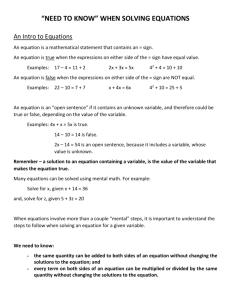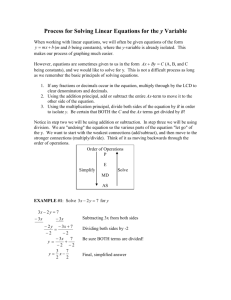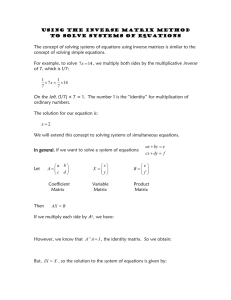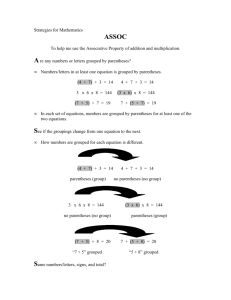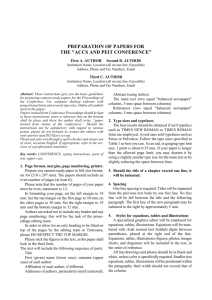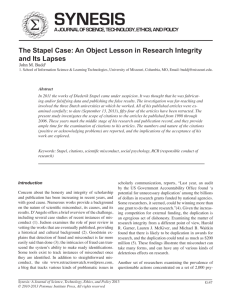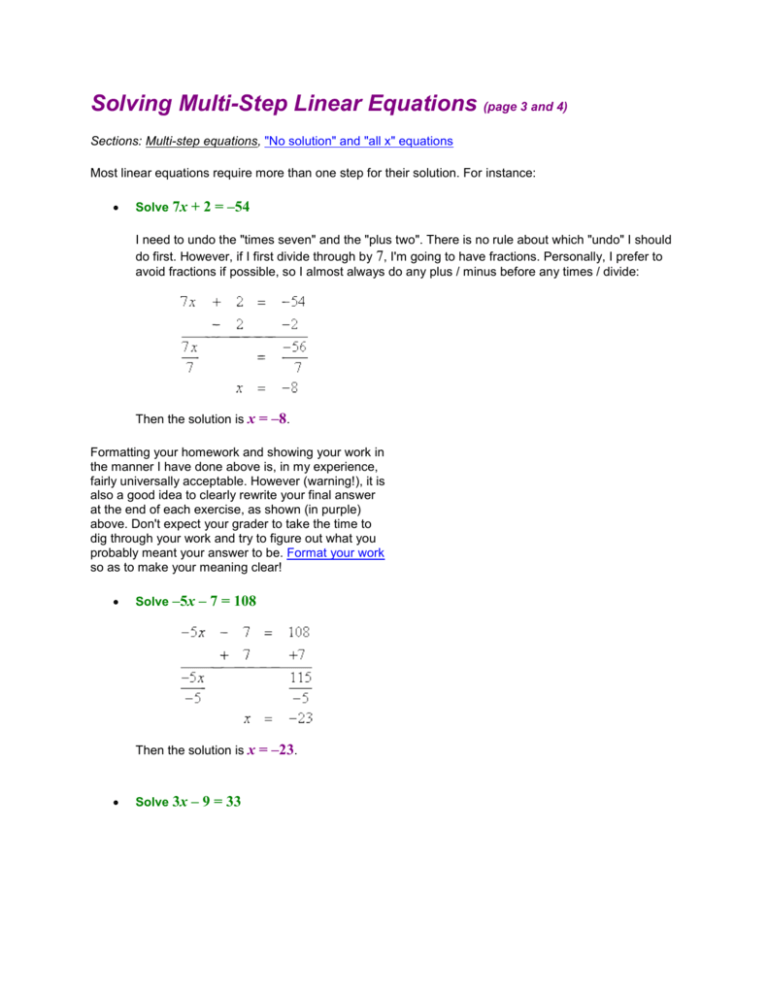
Solving Multi-Step Linear Equations (page 3 and 4)
Sections: Multi-step equations, "No solution" and "all x" equations
Most linear equations require more than one step for their solution. For instance:
Solve 7x
+ 2 = –54
I need to undo the "times seven" and the "plus two". There is no rule about which "undo" I should
do first. However, if I first divide through by 7, I'm going to have fractions. Personally, I prefer to
avoid fractions if possible, so I almost always do any plus / minus before any times / divide:
Then the solution is x
= –8.
Formatting your homework and showing your work in
the manner I have done above is, in my experience,
fairly universally acceptable. However (warning!), it is
also a good idea to clearly rewrite your final answer
at the end of each exercise, as shown (in purple)
above. Don't expect your grader to take the time to
dig through your work and try to figure out what you
probably meant your answer to be. Format your work
so as to make your meaning clear!
Solve –5x
– 7 = 108
Then the solution is x
Solve 3x
= –23.
– 9 = 33 Copyright © Elizabeth Stapel 2002-2011 All Rights Reserved
Then the solution is x
Solve 5x
= 14.
+ 7x = 72
First, I need to combine like terms on the left; then I can solve:
Then the solution is x
Solve 4x
= 6.
– 6 = 6x
I need to move all the x's over to one side or the other. To avoid negative coefficients on my
variables, I usually move the smaller x; in this case, I'll subtract the 4x over to the other side:
Then the solution is x
= –3.
In the above exercise, note that it is perfectly okay to have the " x=" be on the right. The variable is not
"required" to be on the left; we're just used to seeing it there. It's alright if your solution works out with the
variable on the right. However (warning!), I have heard of some instructors who insist that the variable be
placed on the left-hand side in the final answer. (No, I'm not making that up.) If you have any doubts
about your instructor's formatting preferences, ask now.
Solve 8x
– 1 = 23 – 4x
Then the solution is x
Solve 5
= 2.
+ 4x – 7 = 4x – 2 – x
Before I can solve, I need to combine like terms:
Then the solution is x
= 0.
It is perfectly fine for x to have a value of zero. Zero is a valid solution. Do not say that this equation has
"no solution"; it does indeed have a solution, that solution being x = 0.
Solve 0.2x
+ 0.9 = 0.3 – 0.1x
This equation solves just like all the other linear equations. It just looks worse because of the
decimals. But that's easy to fix: however many decimal places I have, I can multiply by " 1"
followed by that number of zeroes. In this case, I'll multiply through by 10:
10(0.2x) + 10(0.9) = 10(0.3) – 10(0.1x)
2x + 9 = 3 – 1x
Then I solve as usual:
2x + 1x + 9 – 9 = 3 – 9 – 1x + 1x
3x = –6
x = –2
If one of the decimals had had two decimal places, then I'd have multiplied through by 100; for three, I'd
have multiplied through by 1000.
Solve
To simplify my computations for equations with fractions, I can first multiply through by the
common denominator. For this equation, the common denominator is 12:
3x + 12 = 2x + 6
3x – 2x + 12 – 12 = 2x – 2x + 6 – 12
x = –6
Solve 11
+ 3x – 7 = 6x + 5 – 3x
First, combine like terms; then solve:
Then the "solution" is "no solution".
When you try to solve an equation, you are starting from the (unstated) assumption that there actually is a
solution. When you end up with nonsense (like the nonsensical equation " 4 = 5" above), this says that
your initial assumption (that there was a solution) was wrong; in fact, there is no solution. Since the
statement "4 = 5" is utterly false, and since there is no value of x that ever could make it true, then this
equation has no solution.
Advisory: This answer is entirely unlike the answer to the previous exercise, where there was a value of x
that would work. Don't confuse these two very different situations: "the solution exists and has the value
of zero" is not in any manner the same as "no solution value exists at all".
And don't confuse the "no solution" type of equation above with the following type:
Solve 6x
+ 5 – 2x = 4 + 4x + 1
First, I'll combine like terms; then I'll solve:
Is there any value of x that would make the above statement false? Isn't 5 always going to equal
5? In fact, since there is no "x" in the solution, the value of x is irrelevant: x can be anything I
want. So the solution is "all x".
This solution could also be stated as "all real numbers" or "all reals" or "the whole number line"; expect
some variation in lingo from one text to the next. Note that, if I had solved the equation by subtracting a 5
from either side of 5 + 4x = 5 + 4x to get "4x = 4x", I would have ended up with nothing other than
another trivially-true statement. I could also have subtracted both 4x and 5 from both sides to get "0 = 0",
but the solution would still be the same: "all x". Don't be surprised if, for "all real numbers" or "no solution"
equations, you don't necessarily have the exact same steps as some of your fellow students. Since there
are infinitely-many always-true equations (like "0 = 0") and infinitely-many nonsensical equations (like "3
= 4"), there will be many ways of arriving at these answers.
Solve 9
= 3(5x – 2)
First, I have to multiply through the parentheses on
the right. Then I can proceed in the usual way:
Then the solution is x
Solve 6x
= 1.
– (3x + 8) = 16
Be careful with taking negatives through parentheses. If it helps you to put a "1" in front of the
parentheses, then do so. Copyright © Elizabeth Stapel 2002-2011 All Rights Reserved
I"ll simplify on the left-hand side first; then I'll solve in the usual way:
Then the solution is x
Solve 7(5x
= 8.
– 2) = 6(6x – 1)
I have to be sure to take the 7 and the 6 all the way through their respective parentheses.
Then the solution is x
= –8.
For this type of problem, take your time and write out all of your steps. Don't try to do everything in your
head.
Solve 13
– (2x + 2) = 2(x + 2) + 3x
Multiply through the parentheses (a minus sign on the left, and a two on the right), combine like
terms, simplify, and solve:
Then the solution is x
= 1.
Don't forget: There is never any reason to be unsure of your solution: you can always check your answer
to any equation-solving exercise! The point of a solution is that it is the x-value that makes the equation
true. To check your answer, plug your solution back into the original equation, and make sure that the
equation "works". For instance, in the last exercise above, my solution was x = 1. Here's the check:
13 – (2x + 2) = 2(x + 2) + 3x
13 – (2[1] + 2) ?=? 2([1] + 2) + 3[1]
13 – (2 + 2) ?=? 2(1 + 2) + 3
13 – (4) ?=? 2(3) + 3
13 – 4 ?=? 6 + 3
9=9
So the solution "checks", and I know that my answer is correct.
Advisory: This ability to check your answers can come in handy on tests. Once you've completed all the
questions, go back and plug in your solutions. If the solution "checks", then you know you got that
question right. If it doesn't check, then you have the chance to correct your mistake before you hand in
the test!


